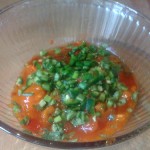Makes one 1lb loaf
155g organic wholemeal flour
155g strong white flour
5g sea salt
5g vegetable fat
8g fresh yeast
190ml water (tepid)
15ml fresh milk
For the Egg/Milk Glaze
1 egg/35ml milk
Place the flours, fat and salt into a mixing bowl. Rub in the fat until it forms a fine crumb with the flour. In a small jug dissolve the yeast in the tepid water. Add this to the dry ingredients together with the milk. Mix by hand until all the ingredients are combined together into a dough.
Once everything is combined, the dough is ready to be kneaded. This can be done by hand, for approximately 8-12 minutes, until the dough becomes smooth and elastic.
After kneading, mould into a ball, leave to rest for 5 minutes and then mould into a loaf shape and place into a lightly greased small loaf tin. Glaze the bread with a brush of egg wash and decorate if required. Cover with clingfilm and place in a warm area until the dough rises above the tin and springs back slowly when pressed. Place into a pre-heated oven at 200ºC and bake until golden brown and the base sounds hollow when tapped.
Here are Betty’s tips for perfect baking
1. You cannot make a good loaf without a good strong flour. Organic flour gives the best flavour and being free from pesticides and other chemicals will not impede the fermentation of the yeast. Stoneground flours give a better texture to the loaf than flour that has been commercially rolled or tilled. These preferred types of flours are produced by small independent millers such as Shipton Mill and Doves Farm.
2. It is important to keep your flour under the best conditions; a cool, dry and well-ventilated storage place is ideal. Never mix old and new flour, and make sure you always check the use-by date before use.
3. Fresh yeast will give your bread the best flavour. While being easy to handle, it does have a short shelf life. Dried yeasts are more convenient and can still be successfully used to make bread, simply replace half the weight of fresh yeast with dried. It’s important that dried yeast is weighed accurately. If too much is used the taste of the bread will be spoiled.
4. When making bread it is important to have your liquid at the correct temperature. If the liquid is too hot it will kill the yeast and if it’s too cold then the yeast’s growth will be inhibited and the dough will become under ripe. The ideal liquid temperature is between 30-37°C, however this is dependent upon the ambient temperature and temperature of other ingredients and equipment.
5. To improve the flavour and speed up the fermentation of the dough a starter sponge can be made. Take the yeast and water from the recipes and mix with a 1/3 of the flour in the recipe. Place the mix in a warm place and leave to rise and go frothy, this should take around 20 – 30 minutes.
6. When kneading dough you need to work quickly and you can’t take any short cuts. Be firm with the dough but not rough, and only lightly dust the surface and your hands with flour when necessary. Keep the work surface clean and free from any crumbs of dough, this will keep the dough smooth and give a good final appearance.
7. Use only glass or plastic bowls for mixing and proving. Do not use metal as this may taint the dough.
8. When proving always keep the bread dough covered, away from any draughts, in order to prevent “skinning”, which would spoil the final baked appearance. Use a damp tea towel (which may need re-damping during the proving) or greased clingfilm.
9. It is worth investing in an oven thermometer. A very hot oven is required to produce a good loaf of bread. Get to know your oven, it is a vital tool in breadmaking.
10. Once you have a good recipe and follow the basic principles, the secret to making the perfect loaf of bread is practice, practice, practice.






